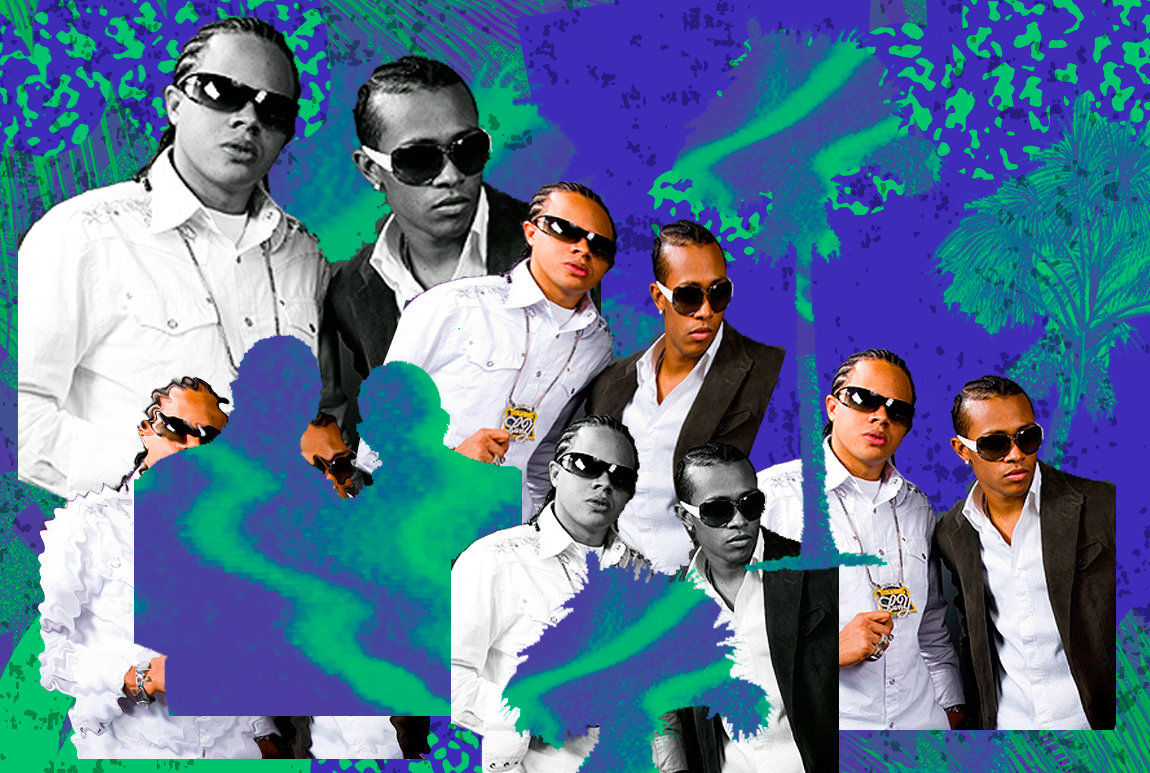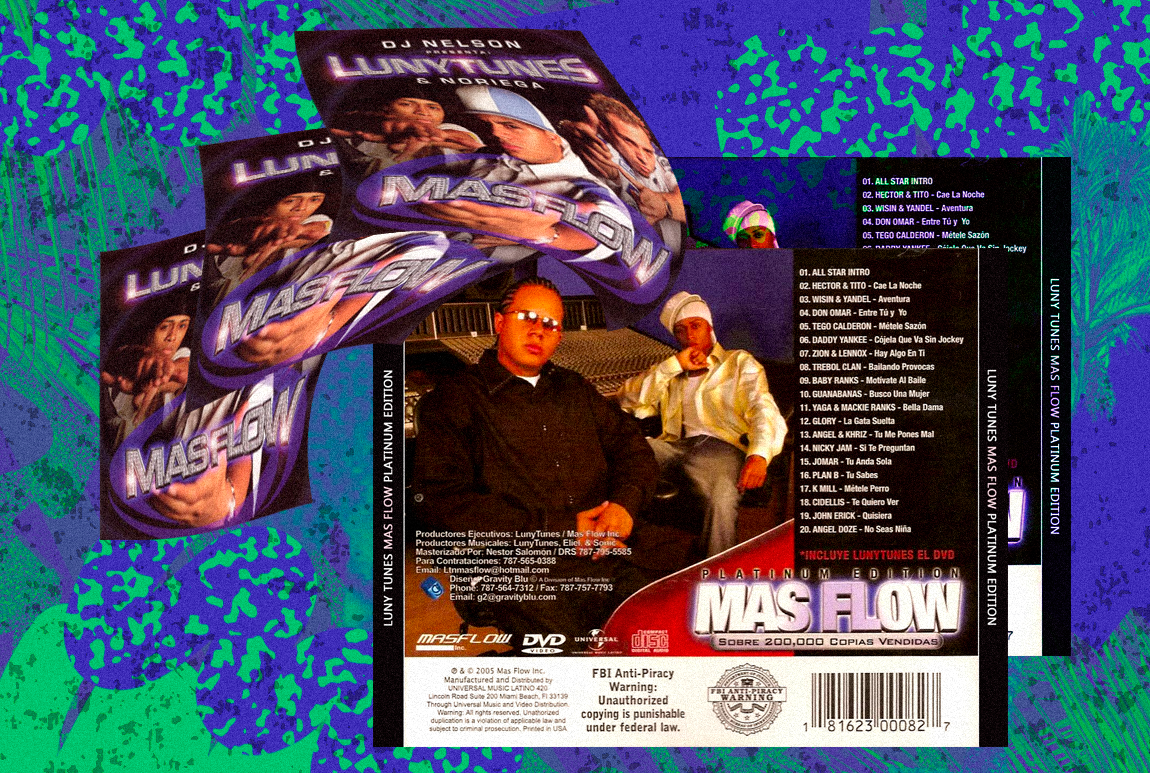Reggaeton began organically as a transformation of dancehall, hip-hop, and reggae en español. As an Afro-diasporic movement, Panama, Puerto Rico, Jamaica, the Dominican Republic, and New York are all pivotal landscapes in the style’s musical evolution. Through Tu Pum Pum: The Story of Reggaeton, a new column by Eddie Cepeda, we’ll explore reggaeton’s history, sociopolitical struggles, and its impact as a global force in music and culture.
It’s 1 a.m. at the perreo function, and the room’s getting musty from bodies pressed against one another dandole hasta abajo. An unmistakable synthesized horn hits, and the club collectively gasps. An hour of gunshots, moaning, and that delectable dembow-backed perico ripiao awaits. Everyone sings “Este menor que usted/La quiere conocer” and the club buzzes with anticipation. Later, unbridled pandemonium hits when the beat drops. “No me importa que usted sea mayor que yo” roars over the crowd. It’s bachatón hour. And Luny Tunes are the conductors.
Francisco Saldaña and Víctor Cabrera, better known as prolific production duo Luny Tunes, brought bachatón – the reggaeton and bachata hybrid that fueled many of their hits – to the world. As we all know, they’re responsible for countless golden-era reggaeton bops like “Gasolina,” “Rakata,” and even deep cuts like “Slow Motion.” Luny Tunes’ music led reggaeton’s blitz from underground clubs to your ‘96 hatchback’s busted speakers. Their use of techno-friendly software like Fruity Loops, coupled with bachata instrumentation, helped fuel reggaeton’s commercial explosion. Don Omar, Daddy Yankee, Ivy Queen, and countless others relied on these two wunderkinds to provide them with the soundtrack to reggaeton’s first global takeover.
The debate about reggaeton’s origins continues. And as we’ve examined in previous installments, Jamaica, Panama, and Puerto Rico certainly played major roles in founding the beloved and oft-maligned genre. Foundational arguments aside, it’s important to look at the genre’s history of transculturation – the perennial sharing of ideas, sounds, and racial identities – and how two Dominicans helped shape reggaeton’s first major commercial peak.
The ritzy student dining halls of Harvard were an unlikely place to find reggaeton’s mainstream architects, but as we’ve learned from the genre, greatness is often launched from implausible places. As scholars have pointed out, New York is often looked upon as one of the key sites for reggaeton’s growth and popularization, but to imagine that two of the genre’s most important figures met and honed their craft in Boston can be surprising to some.
“When I put Luny Tunes and Noriega together in a studio, the genre changed completely.”
Saldaña and Cabrera immigrated to western Massachusetts from the Dominican Republic as teens, working their way through back-of-the-house service industry jobs. When Saldaña (Luny) landed a gig at Harvard’s Leverett Dining Hall, he quickly took his friend Cabrera (Tunes) with him. They worked as cooks and dishwashers, respectively, and spent what little time they had outside of work perfecting their sound on their home studios. “It was hard for me, because I used to go to work in the morning. I was tired all the time,” Luny told The Harvard Crimson in 2006. “It was usually after work we would make music, because it was more like a hobby,” added Tunes.
Their ambition overshadowed the daily grind of keeping Ivy League students fed, and they made it known to those around them. Luny often spoke about their future as bonafide hitmakers, which their coworkers chalked up to delusions of grandeur.

But kismet pulled them out of the service industry when a beat of theirs made its way to Flow Music CEO DJ Nelson. “I was looking for producers, and I found these kids from Boston and nicknamed them Luny Tunes. They looked like babies. At first, Luny didn’t like the name, but he came around after a day,” Nelson tells Remezcla in an interview. “When I put them and Noriega together in a studio, the genre changed completely,” he says.
Of course, the game-changing moment he’s referencing is Luny Tunes’ and Noriega’s work on Mas Flow, which, along with Tego Calderón’s El Abayarde (on which they also have production credits), is what many consider the turning point for reggaeton’s commercialization. Its wide success, and heavy-hitting list of guest talent, catapulted reggaeton to the mainstream, and in the process, cemented Luny Tunes as the movement’s go-to producers.
We all know the daunting number of reggaeton classics that came from just the first two installments of the Mas Flow compilations. And though these recordings weren’t the first to infuse the sounds of merengue and bachata with reggaeton, Mas Flow, and especially its follow-up Mas Flow 2, built on the experimentation that predecessors like DJ Nelson started, and made their sound the reigning style. When Daddy Yankee’s Barrio Fino dropped in 2004, the prolific duo’s unique sound spread to the far reaches of the globe.
Another equally important element to Luny Tunes’ production rested completely outside of the scope of bachata, merengue, or any perceived Latin American sounds. A now-rebranded beatmaking program, then called Fruity Loops, also helped shape their technique.
As Wayne Marshall points out in his essay “From Música Negra to Reggaeton Latino,” Luny Tunes productions like “Gasolina” radiated with “brittle, chintzy, ‘preset’ virtual instruments from such popular music software as Fruity Loops.” Some of us might be old enough to remember downloading free demo versions of the software and navigating its wide-range of rave-friendly synth and keyboard sounds.
The ability to easily engineer professional sounds from home computers gave reggaeton a newfound sheen, and the club-ready presets on these programs blended with musical references to the duo’s Dominican roots, creating a dancefloor-filling iteration of reggaeton that changed the genre.

From neo-perreo to the Colombian hit factory currently monopolizing the charts, to niche sub-genres like moombahton, the illustrious dembow riddim provides the backbeat for a continually shifting reggaeton story told by Latinx diaspora in places like Stockholm or London. Or in the case of Luny Tunes, Boston. The duo perfected an iteration of reggaeton that spoke to their shared history. They took the merengue of their childhood, and used the tools available to them to modernize the genre for chart takeover. The world took notice, and reggaeton broke.
The world took notice, and reggaeton broke.
With a new studio in Miami, and continuing collaborative partnership with Mas Flow alum Predikador, it seems as though 2018 could finally be the year we see a completed and long in-the-works Mas Flow 3.
Reggaeton has always reinvented itself through culture and geography. Luny Tunes’ use of bachata, merengue, and other so-called “Latin” music signifiers made the genre more identifiable to mainstream audiences (though some perceive this as an erasure of the genre’s black roots, while others may see it as the next logical step in a genre’s transformation). But from Jamaica’s dancehalls to Harvard’s Leverett Dining Hall, innovators like Luny Tunes continuously reworked the boom-chk backbeat to represent their experiences. And much like the work they did in Harvard’s kitchens, when it came to reggaeton, these two Dominicans embodied Tego’s memorable lyrics. Le metieron sazón, bateria y reggaeton.
Stream a playlist featuring Luny Tunes deep cuts curated by Boricua-Panameña DJ Bembona:







